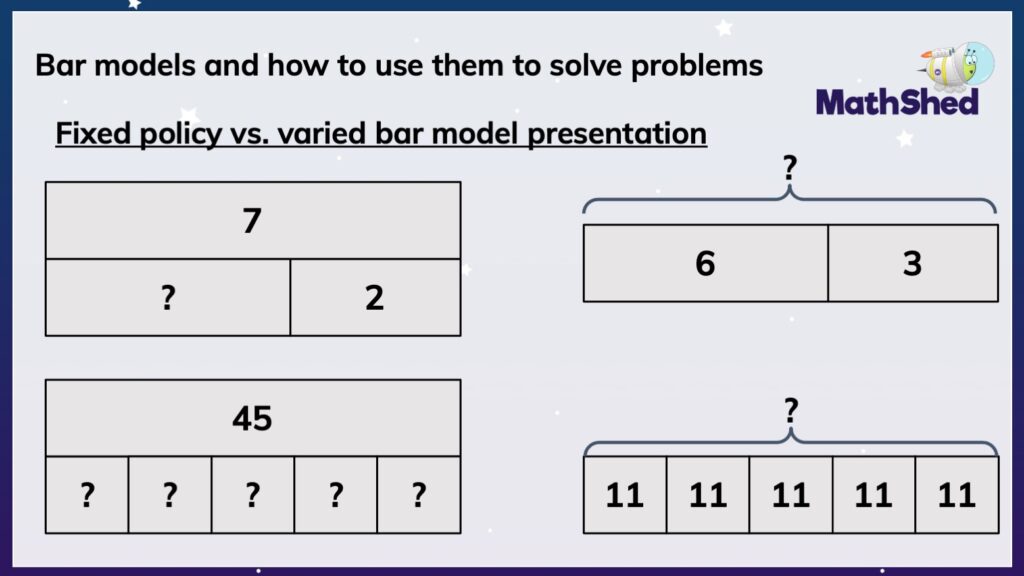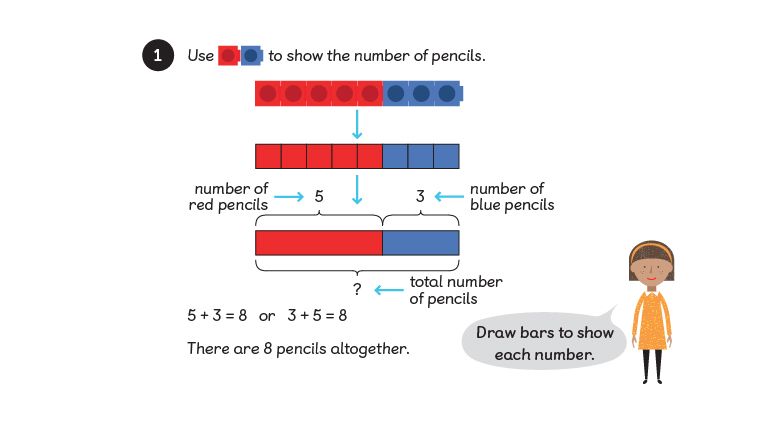The importance of bar model drawing techniques in interactive math learning
Exploring Bar Design Illustration Techniques: A Comprehensive Guide to Picturing Math Concepts
Bar model drawing techniques function as a valuable resource for both educators and trainees in envisioning mathematical concepts. These versions streamline complicated mathematical partnerships, aiding in the understanding of enhancement, department, multiplication, and subtraction. This guide describes effective techniques for executing bar designs, fostering active engagement and real-world links. As readers explore the sensible applications and mentor pointers, they will certainly discover how these techniques can transform their strategy to maths.
Comprehending the Fundamentals of Bar Model Illustration
Bar model attracting functions as a powerful aesthetic device in maths, assisting in the understanding of numerical partnerships and analytical approaches. This technique includes representing numbers and their relationships through rectangle-shaped bars, making it much easier to envision operations such as addition, subtraction, multiplication, and department. Each bar's length represents a details value, enabling learners to compare amounts and recognize proportions clearly.
To develop a bar model, one starts by recognizing the issue's crucial elements, often damaging it down right into components that can be visually represented. In a straightforward enhancement problem, 2 bars can be drawn, with their sizes representing the addends. The mixed length shows the sum. In addition, bar versions can be adjusted for extra complex problems, consisting of ratios and fractions, by adjusting the bars as necessary. Grasping these fundamentals lays a strong structure for efficient analytic and much deeper mathematical comprehension.
Benefits of Using Bar Designs in Math
Using bar designs in maths provides various benefits that boost discovering and comprehension. These graphes help students in grasping intricate principles by damaging them down right into convenient parts. Bar designs provide a clear structure for showing relationships between numbers, making abstract concepts much more concrete. They promote a much deeper understanding of mathematical procedures and assist in analytical by enabling learners to envision the data they are dealing with.
Additionally, bar models support the development of crucial believing abilities, as trainees should assess and analyze the aesthetic information to draw final thoughts. This method urges active engagement with the product, strengthening retention and proficiency of mathematical concepts. By fostering a solid foundation in aesthetic literacy, bar models equip students to approach various mathematical challenges with self-confidence. On the whole, the combination of bar models right into mathematics education and learning verifies helpful in cultivating both understanding and logical capabilities amongst pupils.
Applying Bar Designs to Enhancement and Reduction
Bar models offer as an effective tool for visually standing for enhancement and reduction problems. By showing the partnership between numbers, they enhance understanding and facilitate analytic. On top of that, real-life applications of these models can help learners understand mathematical ideas in practical contexts.
Representing Enhancement Visually
When trainees run into addition and reduction issues, aesthetic help can substantially boost their understanding of these procedures. Bar designs serve as effective devices for representing enhancement. By splitting a rectangular shape into segments that represent the numbers involved, students can picture the relationship between the amounts. For circumstances, if a trainee needs to add 3 and 5, they can develop a bar divided into two sections: one area standing for 3 and the other representing 5. This clear depiction not just simplifies the addition process however likewise reinforces the principle of combining amounts. As trainees adjust these visual aids, they establish a much deeper comprehension of enhancement, leading to enhanced analytic abilities and better confidence in their mathematical capabilities.
Subtraction With Bar Versions
Subtraction is commonly regarded as an extra complex operation than enhancement, bar models can effectively clarify this process for trainees. By aesthetically standing for the amounts entailed, pupils can much better understand just how numbers relate to each other. In a bar design for reduction, one bar represents the total amount, while another shows the amount being subtracted. This aesthetic distinction aids students comprehend the principle of "taking away." As an example, if a bar reveals 10 systems, and an additional bar standing for 4 units is eliminated, students can conveniently see that 6 units remain. This technique not only fosters understanding of reduction however also aids in establishing analytical skills, allowing pupils to picture their mathematical reasoning and enhance their total comprehension of mathematical principles.
Real-Life Application Instances
Recognizing subtraction via bar versions lays a structure for applying these methods in real-life scenarios. In numerous contexts, such as budgeting or buying, people can picture exactly how much cash remains after expenditures. If a person has $50 and spends $20, a bar version can represent the complete amount and the invested part, highlighting that $30 is left. Additionally, moms and dads can use bar designs to assist children recognize the amount of more items require to be included to finish a set, such as having 3 apples and needing five. This aesthetic depiction streamlines intricate troubles, facilitating comprehension and retention. Inevitably, bar versions work as reliable devices in everyday decision-making, improving mathematical understanding in practical scenarios.
Envisioning Reproduction and Department With Bar Versions
In discovering the application of bar designs for multiplication and division, it is essential to grasp their fundamental ideas. Constructing reproduction versions enables students to imagine partnerships in between numbers, while effective department methods can be highlighted via these visual aids. This approach boosts comprehension and problem-solving skills in maths.
Comprehending Bar Versions
Bar designs function as an effective visual tool for highlighting the concepts of multiplication and division. They make it possible for students to represent mathematical partnerships in an organized format, helping with a deeper understanding of these procedures. In reproduction, bar versions show groups of equivalent size, allowing people to visualize the total quantity when integrating these teams. On the other hand, in division, bar versions assist depict how a total amount is split right into smaller sized, equal components, clearing up the concept of dividing. By utilizing these visual aids, students can grasp the underlying principles of reproduction and division more properly. This approach not only enhances understanding however also sustains analytic abilities, making bar models a vital asset in mathematical education.
Building Multiplication Versions
Building reproduction versions making use of bar layouts provides a clear approach for picturing the procedure of multiplication. These models make it possible for learners to stand for multiplication as groups of equal components, making abstract ideas a lot more concrete. As an example, to illustrate (3 times 4), a trainee can attract one bar separated into 3 equal sections, each representing four units. Furthermore, creating a 2nd bar with the very same length strengthens the understanding of duplicated addition, as each section represents one group. This graph not only help in understanding multiplication yet also boosts analytical skills. By employing bar models, pupils can much better understand relationships between numbers and create a robust foundation for a lot more intricate mathematical ideas, resulting in boosted confidence in their abilities.
Visualizing Department Techniques

Solving Word Troubles Utilizing Bar Version Techniques

In an issue involving addition and reduction, trainees can attract different bars for each quantity and after that manipulate them to find the solution. This process not only clarifies the problem but additionally fosters a deeper conceptual understanding. Furthermore, bar versions can be adapted for numerous sorts of word issues, making them versatile across different mathematical subjects. Inevitably, utilizing bar models can significantly enhance pupils' analytical abilities by supplying a clear visual pathway to get to the proper solution.
Integrating Bar Models in Various Mathematics Topics
Bar designs can be flawlessly integrated into numerous mathematics subjects, enhancing students' understanding of ideas beyond fundamental arithmetic. In algebra, these visual tools help in representing inequalities and formulas, enabling learners to picture relationships between variables. When taking on geometry, bar designs can highlight the buildings of shapes and spatial reasoning, assisting students realize principles like location and border efficiently. In data, bar models assist in the analysis of information sets, permitting pupils to contrast amounts and more info acknowledge fads visually. In addition, incorporating bar designs within measurement subjects help in comprehending systems and conversions by offering a substantial representation of quantities. By employing bar models across various mathematical locations, instructors can cultivate a deeper understanding of intricate ideas, consequently improving analytical skills and promoting crucial thinking (bar model drawing techniques). This flexibility demonstrates the utility of bar models as a foundational device for pupils in their mathematical journey
Tips for Teaching Bar Versions Properly
Incorporating bar versions right into mentor practices requires thoughtful strategies to maximize their performance. Educators must begin by introducing bar models with easy, relatable examples that pupils can conveniently comprehend. This helps to construct self-confidence and knowledge with the idea. Gradually enhancing the intricacy of issues allows students to use their skills considerably. Furthermore, teachers should encourage trainees to create their own bar designs, promoting energetic engagement and possession of their understanding.
Including collaborative tasks can likewise enhance understanding, as students discuss and fix troubles in teams. Continuous feedback is vital; teachers should offer positive commentary on pupils' bar model representations to direct improvement. Ultimately, attaching bar models to real-life circumstances enhances their significance, aiding students see the practical applications of their mathematical skills. By carrying out these strategies, teachers can effectively harness the power of bar designs in their maths guideline.
Regularly Asked Concerns
Can Prevent Versions Be Made Use Of in Various Other Subjects Besides Mathematics?
Bar designs can without a doubt be made use of in numerous topics past mathematics. They effectively highlight ideas in science, social research studies, and language arts, aiding to aesthetically stand for partnerships, procedures, and ideas for enhanced understanding across techniques.
What Age Team Is Best Matched for Knowing Bar Designs?
Bar designs are best fit for kids ages 7 to 12, as they establish concrete thinking abilities during this duration (bar model drawing techniques). At this age, pupils can effectively grasp abstract principles through graph and problem-solving strategies
Exist Digital Tools for Creating Bar Designs?

Exactly How Can I Examine Pupil Understanding of Bar Versions?
Reviewing pupil understanding of bar models can include quizzes, empirical analyses, and team conversations. Educators may also evaluate students' completed versions and their capability to explain their thinking, making sure a thorough evaluation of comprehension.
What Prevail Mistakes When Using Bar Models?
Usual blunders when utilizing bar models consist of misrepresenting amounts, falling short to precisely label bars, confusing addition and reduction, overlooking to use constant ranges, and neglecting the relevance of clear visual splitting up in between different elements.
In enhancement, bar versions can be adapted for much more complex issues, including portions and ratios, by readjusting the bars as necessary. Reduction is often regarded as a more complicated operation than addition, bar versions can efficiently clarify this procedure for trainees. In a bar version for subtraction, one bar stands for the total, while an additional indicates the amount being deducted. If a bar shows 10 devices, and another bar representing 4 systems is gotten rid of, trainees can conveniently see that 6 units stay. When separating an overall right into equivalent teams, students can draw a long bar to stand for the entire and then sector it right into smaller bars that show each team.